Animals and fantastic places in Italy's museums: Friuli-Venezia Giulia
Stage number seven for our journey through Italian museums in search of fantastic animals and places. Today it is Friuli-Venezia Giulia’s turn: here are the creatures we found in the institutions of this northern Italian region. The Animals and Fantastic Places in Italian Museums project is carried out by Finestre Sull’Arte in collaboration with the Ministry of Culture and aims to bring visitors to museums and places of culture, safe places to learn and at the same time have fun in the company of your family and children.
1. The gryllos of the red jasper gem from the National Museum of Aquileia.
The journey begins at the National Museum of Aquileia where a vast collection of ancient gems is housed. One of these, dating from the second century AD, bears an engraved bizarre figure, a gryllos: this Greek term, which we find in literary sources, indicated grotesque compositions of human and animal parts, not necessarily corresponding to creatures attested in mythology, but often the product of the artist’s imagination. According to Pliny the Elder, the originator of the grylloi would have a name: he would in fact be the Greek painter Antiphilos. We do not know what was the meaning of these figures, which often gave rise to fantastic images: perhaps they were caricatures, perhaps they had magical or ritual meanings. The fact is that in the first and second centuries CE these compositions were very common. Usually, the head was reserved for the human part while the body took the form of objects or animals: in this case, we are dealing with a strange creature with a human head (but equipped with horns) and the body of a fish.
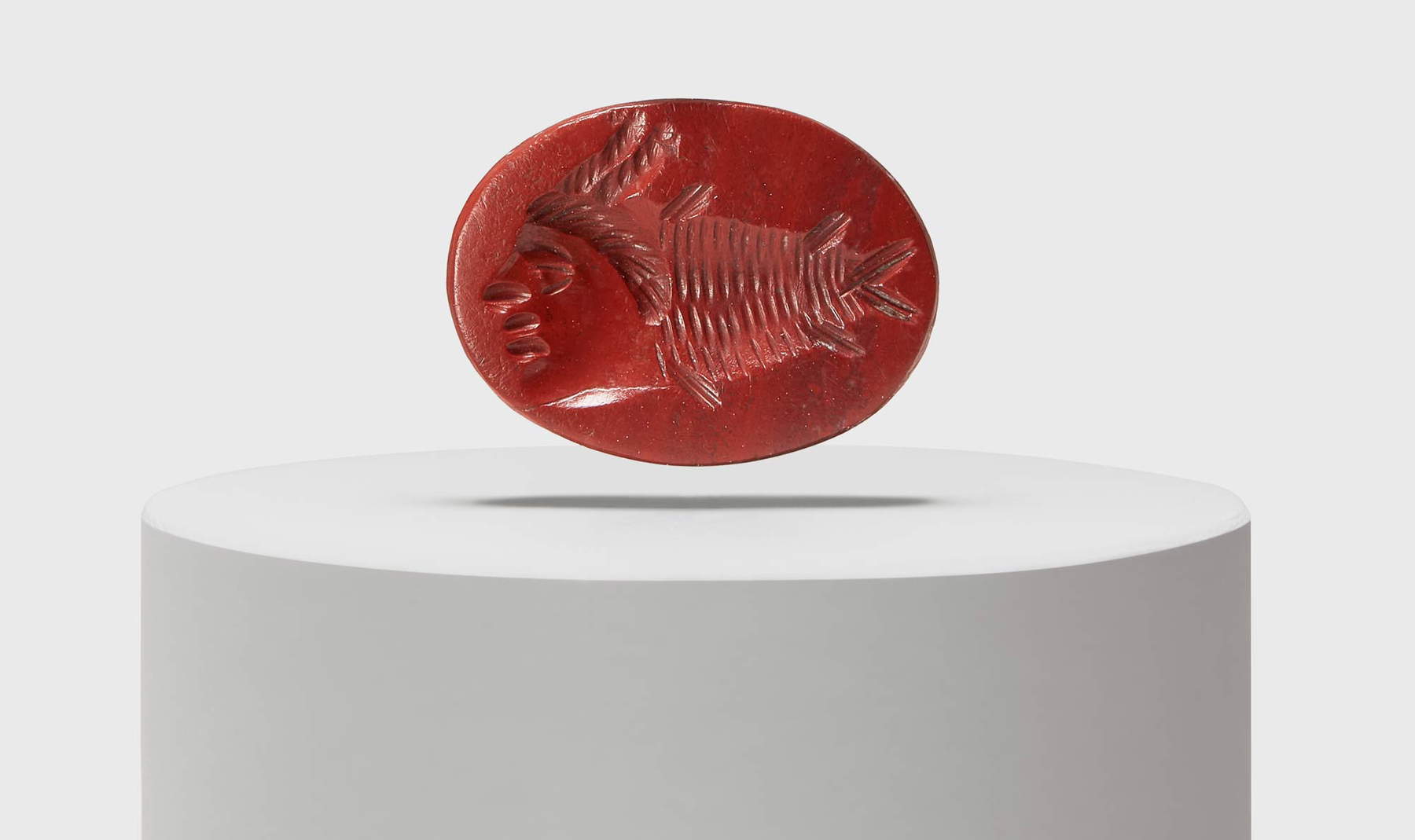
2. The hippocampus in the mirror at the National Archaeological Museum in Aquileia.
In this Roman-era mirror handle (dating from between the first century B.C. and the first century A.D.) we find depicted a woman, wearing a light tunic, caught on her left profile, riding a hippocampus. This term, which has passed into modern zoology to denote the seahorse, in mythology refers instead to a legendary creature that was half horse-bodied (the front part) and half fish-bodied (the back part): it is seen depicted, in particular, with its two equine front legs and a long fish tail. These are animals that, in depictions of marine scenes, usually accompany the procession of the sea god, Poseidon. The hippocampus of the mirror of the MAN of Aquileia is depicted with its tail covered with scales, and with a normal horse mane (indeed, it was not uncommon for these creatures to have a crest of seaweed). We know that this was a mirror handle because on the reverse side this object has a round recess that accommodated the metal part (in ancient times, in fact, one mirrored on thin round metal plates, and finely polished so that they could reflect images).
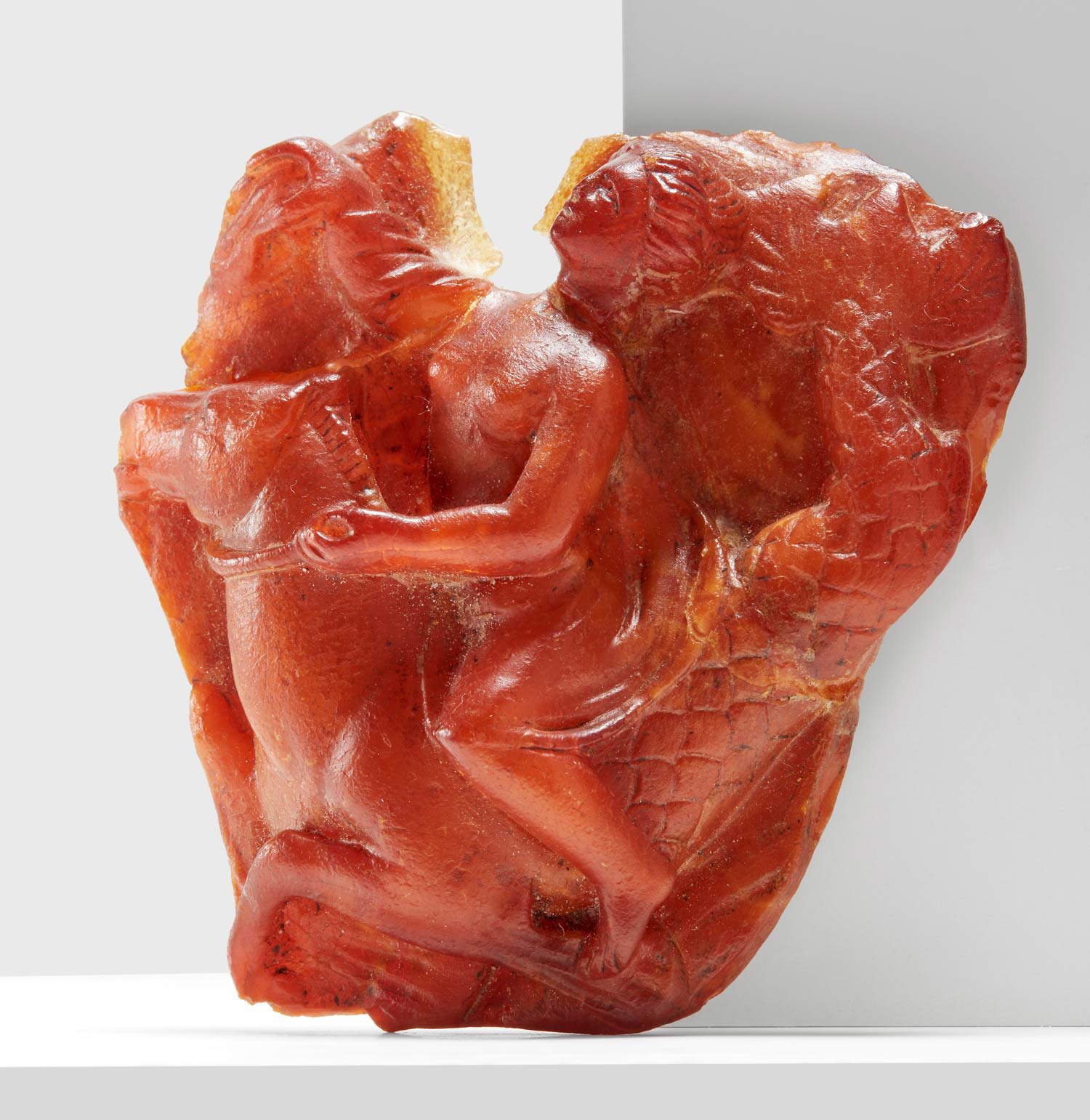
3. The sea bull in the mosaic of the National Archaeological Museum in Aquileia.
This mosaic, which depicts a nereid, or sea nymph, riding a sea bull, is one of the oldest of those found in Aquileia as well as one of the most interesting in the mosaic collection of the National Archaeological Museum in the Friulian city. It was initially thought to depict the mythological episode of the rape of Europa: the princess was in fact abducted by Zeus who had taken the form of a bull. However, the animal has a fish-like tail, an element that has no counterpart in the traditional iconography of the Rape of Europa: so there is little doubt that we are dealing with a nymph, depicted completely naked, riding a fantastic sea creature, especially since a fish also appears beneath her, and what it seems to put around the bull’s head appears to be seaweed. It is not certain, however, that this is not an iconographic contamination between the typical representations of the Nereids and the theme of the Rape of Europa (to which the cupid and the figure we see in the waves refer, which can be interpreted as one of the tritons that accompanied the young girl’s journey). This is a mosaic of great quality that adorned a rich Roman domus in Aquileia, which most likely belonged to a member of the local ruling class. It was discovered between 1859 and 1860, by chance, in a plot of land not far from the Basilica of Aquileia: restored for the first time in the 1920s, it underwent a new intervention between 2016 and 2017.
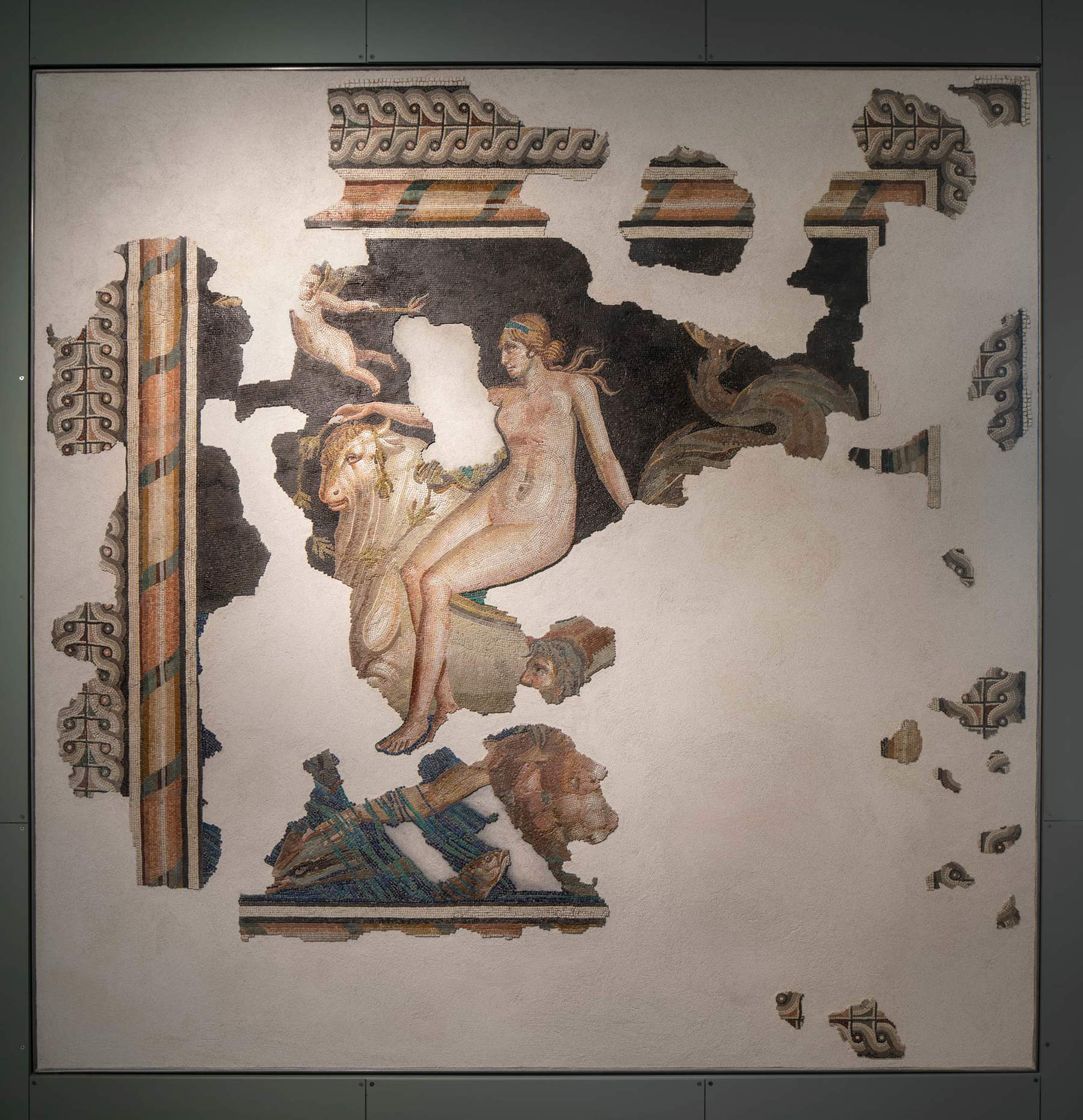
4. The bicaudate mermaid at the National Archaeological Museum in Cividale del Friuli.
At the National Archaeological Museum in Cividale del Friuli is preserved this bicaudate mermaid (i.e., with two fish tails), a late product of Lombard art, at least according to recent critical positions: it is in fact a work that is placed, according to the most up-to-date hypotheses, in the 11th century, on the basis of comparisons with other works of the same period that show similar characters. The fantastic creature in question is presented with highly stylized features, is accompanied by two fish swimming in the sea (rendered only through wavy lines), and holds its two tails with its hands. As can easily be seen, the mermaid has a pose that is anything but demure: she is in fact flaunting her sexual organ, an element that, scholar Paola Refice has written, “accentuates the moral significance of the figure, as well as the hints at the context: the marine setting, the extreme legacy of a naturalistic classicism, which in part frees her from the mere role of symbol and leads her into the realm of a manifestly more descriptive sculpture, not foreign to artistic experiences in northern Italy around the 11th century.” We do not know where this carved slab came from.
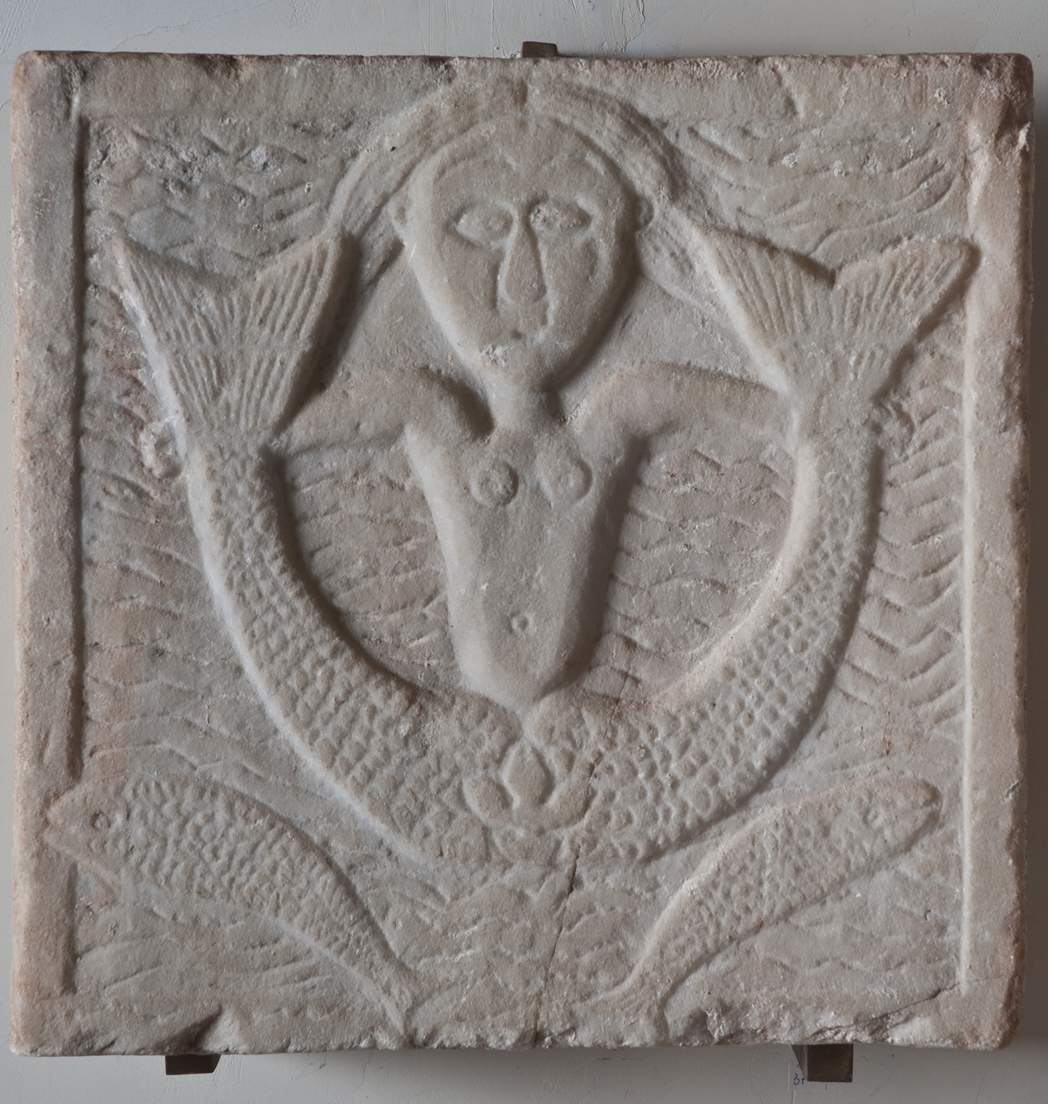
5. The two fantastic animals in the clypeus of the National Archaeological Museum in Cividale del Friuli.
Two fighting animals are the ones facing each other in this marble object, a clypeus, that is, a disk that had decorative functions and in turn bore an image in its center. This one, from the Romanesque period, and dating from the 11th-12th centuries, in ancient times decorated the Patriarchal Palace of Cividale del Friuli: at that time, the Friulian city was one of the most important in northeastern Italy, and it was also for a long time the capital of the Patriarchal Principality of Aquileia, an ancient autonomous state that remained so until 1420, when it was annexed to the Republic of Venice. In the 13th century, Cividale was experiencing a period of great splendor, and the clipeus takes us back to those years. Moreover, it is not the only fragment of the ancient decorations that has survived; the National Archaeological Museum preserves several ornaments from the ancient Patriarchal Palace. The two fighting animals, perhaps two dragons, symbolize the struggle of good against evil.
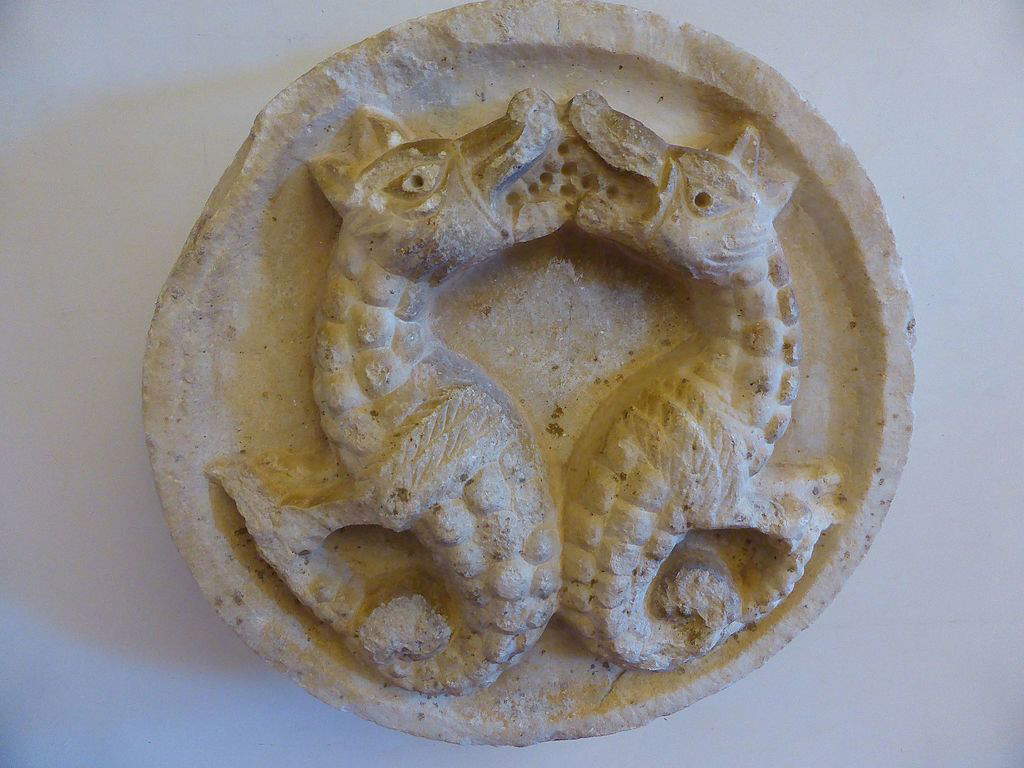
6. The dragon fountain at the Miramare Castle in Trieste.
This bronze dragon decorates the fountain placed on the floor of the first-floor gallery of the Miramare Castle in Trieste, right in front of the window overlooking the gulf. The fountain also had an additional, singular function, namely that of a skylight, as it was equipped with a transparent glass bottom, and thus was able to diffuse light to the ground-floor hall of honor. The pool, designed to house aquatic plants and fish, thus had a dual function: functional and decorative. Similar examples can be found in other residences of the time. The marble border of the fountain is adorned precisely by the four bronze dragons from which a gush of water flows. The dragons of Miramare, explains scholar Francesca Grippi, were “symbolically called upon to guard the residence of Maximilian of Habsburg,” and they evoke, in their appearance and pose, “the gargoyles of Gothic cathedrals, in full coherence with the neo-medieval intonation that largely characterizes the eclectic residence.”
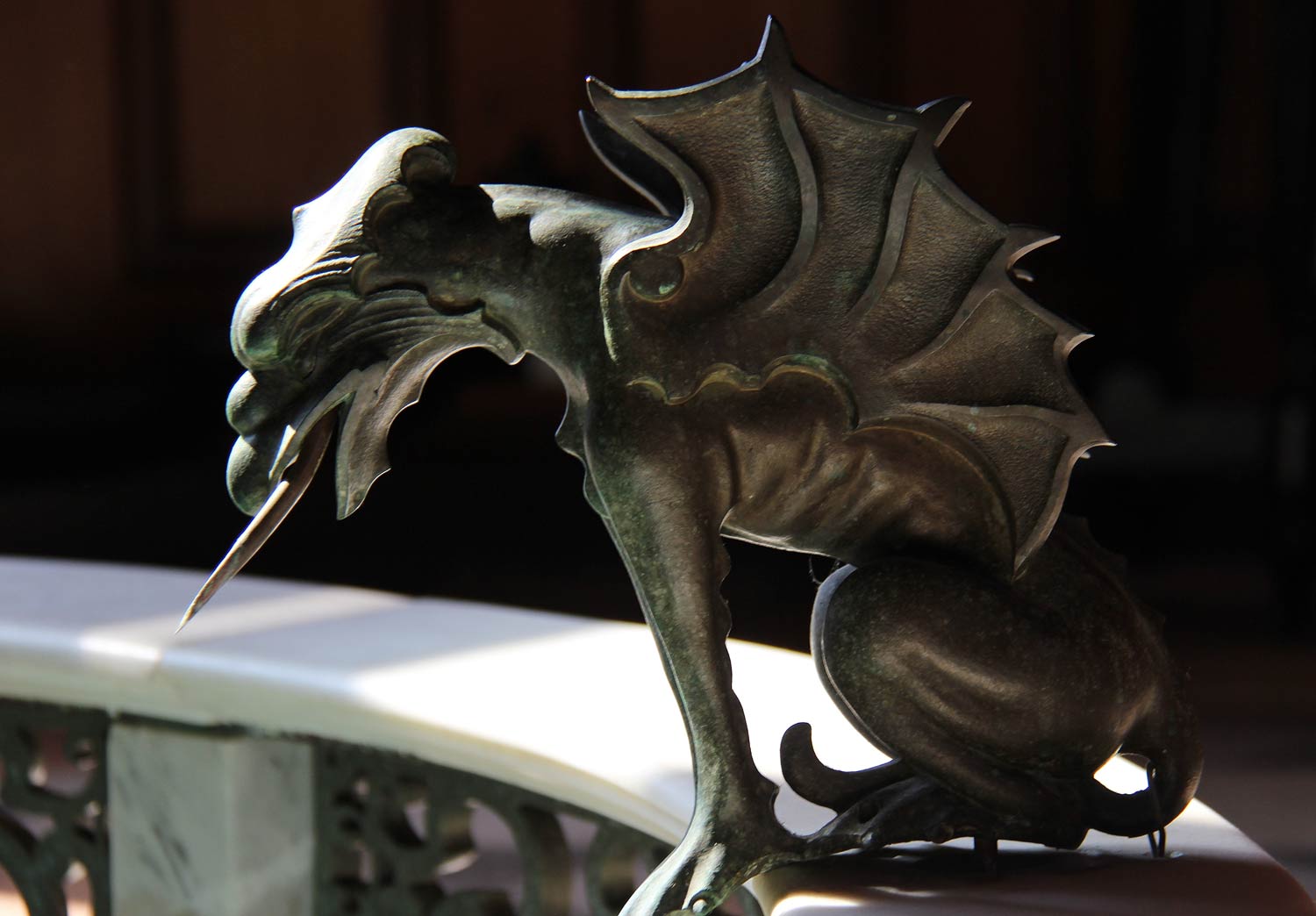
7. The Buddhist lion at the Miramare Castle in Trieste.
The lion is not a fantastic animal, but this one found at the Miramare Castle in Trieste is so singular and so abstract that it could not fail to end up in an in-depth study of fantastic animals: moreover, the way it is presented, with its body all decorated with polka dots, automatically ascribes it to the rank of... fantastic creature, also because of the role it was given. In fact, in Japan, the land from which this sculpture comes, the animal (which has a special name: karashishi, or “Chinese Buddhist lion”) symbolized strength and courage, and what’s more, in the Buddhist tradition this animal always put these characteristics of his in the service of good, and in defense of evil spirits (sculptures of paired lions were placed at temple entrances). This lion dates from the late seventeenth century and is a work of great quality from the town of Arita, which is known for its ceramic tradition: it is a sculpture made from a white, imperfection-free ceramic body, on which the high-gloss glazes that distinguish the lion were then laid. The porcelain in question is named Kakiemon, after the ceramicist Sakaida Kakiemon who, according to tradition, first developed it.
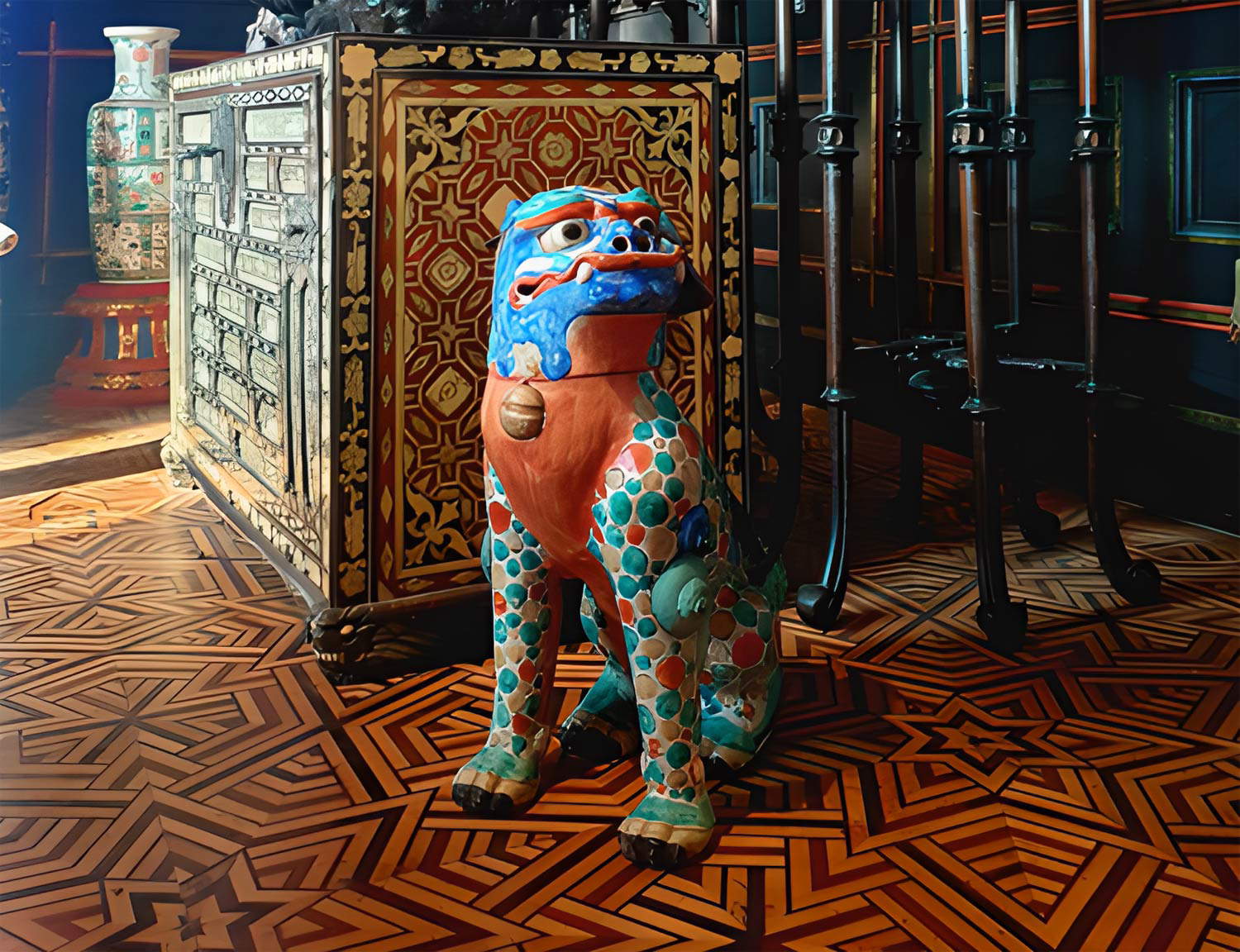
8. The sphinx of the Miramare Castle in Trieste.
This is perhaps the most photographed fantastical animal in Miramare Castle, by virtue of its location: the Egyptian granite sphinx in fact decorates the head of the Miramare pier, and moreover was made famous by Giosuè Carducci’s Miramar ode (“vedi la sfinge tramutar sembiante / a te d’avanti perfida arretrando!”). Although the quality is not sublime, this is a genuine Egyptian sphinx, from the Ptolemaic era (probably 2nd century BCE), placed on top of a gray sandstone plinth that is instead of recent date. It comes from the collection of Egyptian relics that was assembled by Maximilian of Habsburg, a great Egyptology enthusiast, at various stages, although we do not know how it came to the castle: perhaps it was among the objects that Maximilian had brought in through the consul general of Austria, Antonio Larin. Today it is the only survivor of the large collection of antiquities that was amassed by Maximilian: in fact, the rest of the collection was already being shipped to Vienna in 1883 to form the Egyptian collection of the current Kunsthistorisches Museum. “It was in 18th-century France,” explains art historian Claudio Barbieri, “that the esoteric and initiatory appeal of the sphinx rose to a typical decorative motif for palace gardens throughout Europe. Examples include the Belvedere in Vienna, the Sanssouci Park in Potsdam, the Royal Palace of the Granja de San Ildefonso in Spain, the Branicki Palace in Bialstok, Poland, and the National Palace of Quieluz in Portugal. Archduke Ferdinand Maximilian of Habsburg Lorraine, an attentive devotee of the mysterious Orient, drew on this courtly tradition of garden architecture, placing the fabulous creature to crown and imperishably protect Miramare Castle.”
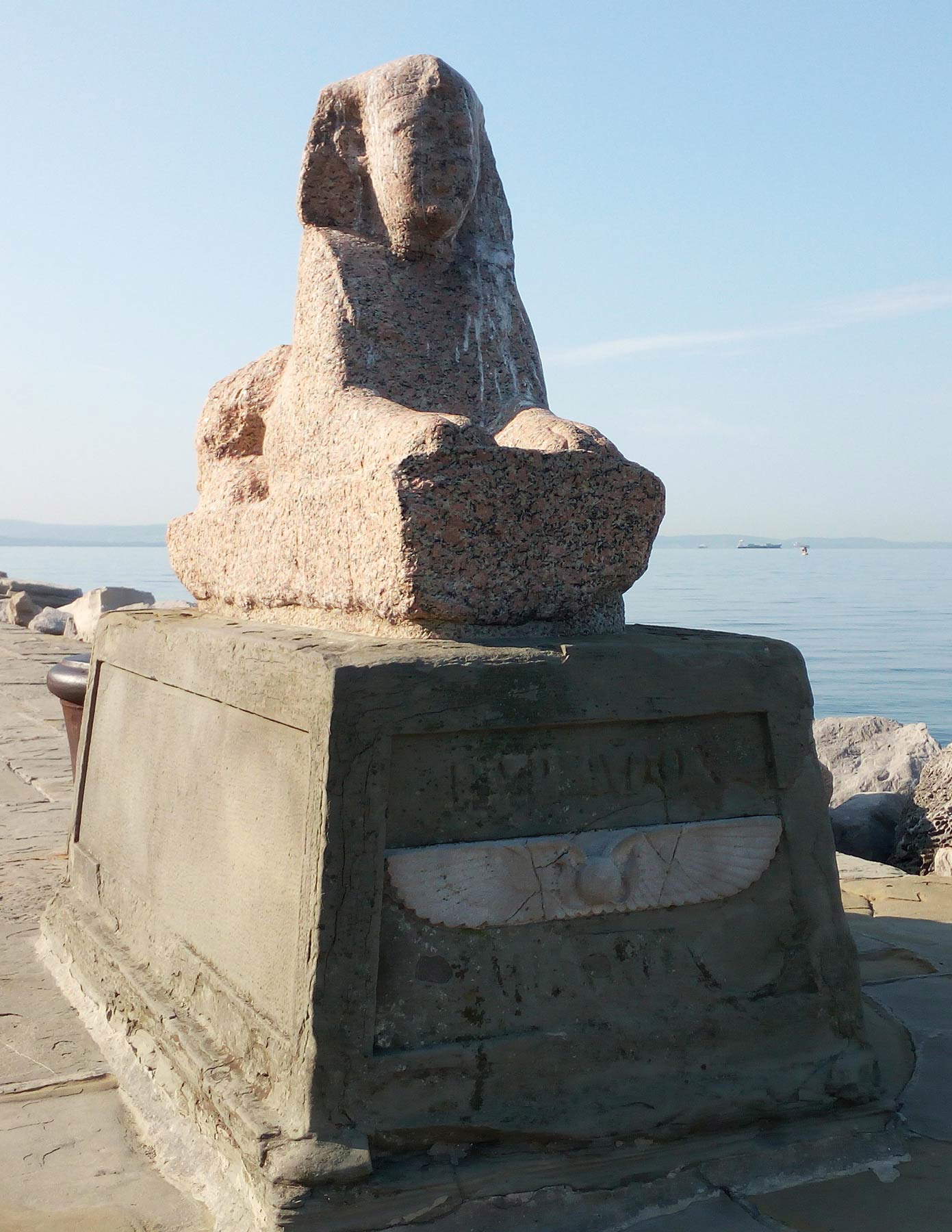
9. The dragons of the Japanese vase from Miramare Castle.
An important object of Japanese production from the mid-19th century, this elaborate vase has some landscape paintings on the body, reminiscent of traditional Chinese painting. The Japanese provenance is confirmed by the choice of enamel tones decorating the exterior, which are typical of Japanese art (especially with regard to the orange background). In addition, we also see, among the decorative motifs, some chrysanthemums, flowers dear to Japanese tradition. The fantastic animals, in this vase, are... in the handles: in fact, we see two dragons acting as handles, according to a decorative mode that was also typical of Chinese ceramics (in fact, a Chinese vase with dragon-shaped handles is also preserved in Miramare). In this case the dragons are also colored very finely and with great attention to detail.
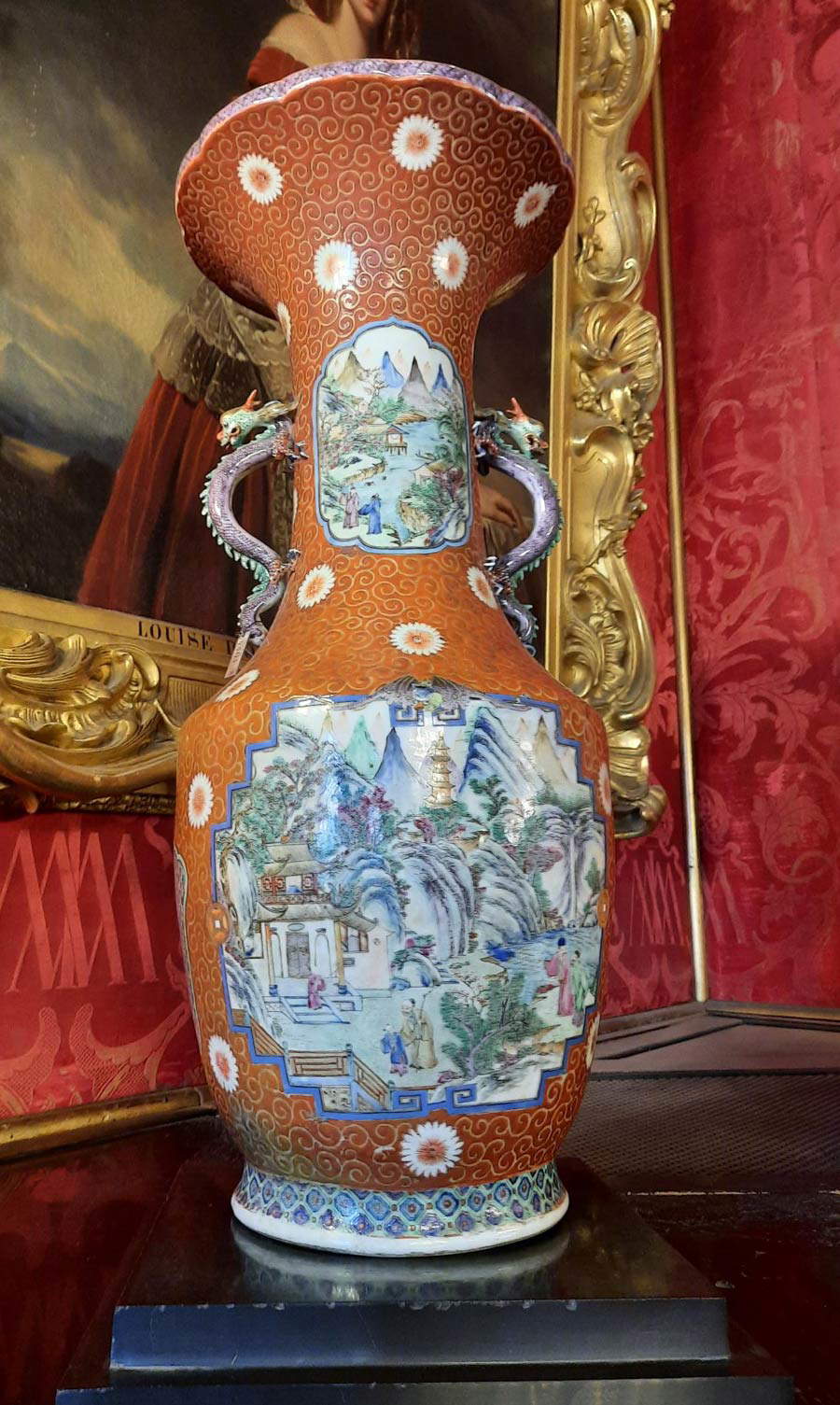
10. The mermaid of the aryballos from the Winckelmann Museum in Trieste.
A mermaid, depicted according to Greek mythology (i.e., with the body of a bird and not a fish: this iconography would spread only in the early Middle Ages), decorates the surface of this Corinthian aryballos, from the 7th-6th century B.C., preserved at the “Johann Joachim Winckelmann” Civic Museum in Trieste. Thearyballos was a small vessel, usually globular in shape with a wide mouth at the top, which was used to store perfumes, ointments or skin oils. In Greek mythology, sirens were not found in the depths of the sea, but if anything, on the coasts. In fact, they lived among the rocks and it was on the coast that Odysseus heard them singing in the famous episode of the Odyssey. According to mythological tradition, in fact, Sirens were endowed with a very suave voice capable of enticing sailors, causing them to shipwreck.

 |
| Animals and fantastic places in Italy's museums: Friuli-Venezia Giulia |
Warning: the translation into English of the original Italian article was created using automatic tools. We undertake to review all articles, but we do not guarantee the total absence of inaccuracies in the translation due to the program. You can find the original by clicking on the ITA button. If you find any mistake,please contact us.



























